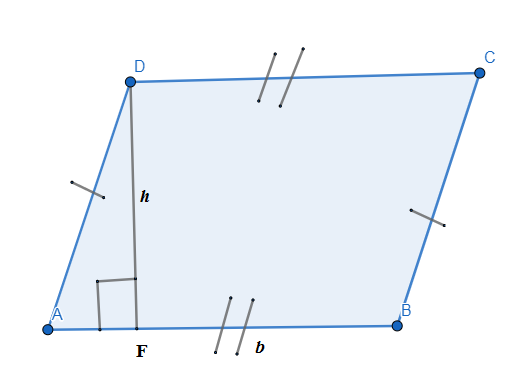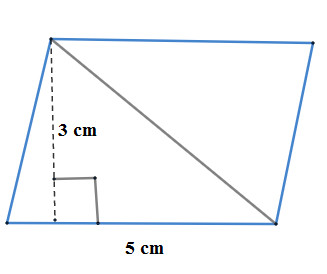
Find the areas of following parallelograms. \[\]


Answer
559.5k+ views
Hint: We recall the definition of parallelogram, the height $h$ of which is length perpendicular dropped from one vertex to opposite side, the base $b$which is the length of the opposite side where foot of the perpendicular lie. We recall the area of the parallelogram as a product of height and base $bh$. We use the length of height and length of base in the given parallelograms and use the formula to get the area. \[\]
Complete step by step answer:

We know that a parallelogram is a quadrilateral where the opposite sides are equal in length and parallel to each other. We have drawn the figure of the parallelogram ABCD where AB=CD and AD=BC. The parallelogram also has equal opposite angles. If draw any perpendicular from any vertex on the opposite side, the perpendicular is called height of the parallelogram conventionally denoted as $h$ and the where the opposite side is called base denoted as $b.$ In the figure the perpendicular is drawn from vertex D on AB. So $h=DF,b=AB$. \[\]
We also know that the area of the parallelogram is the product of the lengths of base and height. So the area $A$ of the of the parallelogram can be written as
\[A=DF\times AB=h\times b=bh\]
Let us observe the first parallelogram. \[\]

The dotted line is perpendicular or height of the parallelogram and length of the height is given as $h=4$cm. The length of the base is given as $b=7$cm. So the area $A$ of the parallelogram is
\[A=h\times b=4\text{ cm}\times 7\text{ cm}=28\text{ c}{{\text{m}}^{2}}\]
Let us observe the second parallelogram. \[\]
.

Here we are given the length of the height $h=3$cm and length of the base $b=5$cm. So the area of the parallelogram is,
\[A=h\times b=3\text{ cm}\times 5\text{ cm}=15\text{ c}{{\text{m}}^{2}}\]
Note: We note that $\text{c}{{\text{m}}^{2}}$ (read as centimetre squared or square centimeter) is a unit of area obtained from multiplying cm with cm. It is not necessary that the height of the parallelogram will lie in the interior of the parallelogram, for example in our figure if we drop perpendicular from C on AB it will lie outside the parallelogram ABCD.
Complete step by step answer:

We know that a parallelogram is a quadrilateral where the opposite sides are equal in length and parallel to each other. We have drawn the figure of the parallelogram ABCD where AB=CD and AD=BC. The parallelogram also has equal opposite angles. If draw any perpendicular from any vertex on the opposite side, the perpendicular is called height of the parallelogram conventionally denoted as $h$ and the where the opposite side is called base denoted as $b.$ In the figure the perpendicular is drawn from vertex D on AB. So $h=DF,b=AB$. \[\]
We also know that the area of the parallelogram is the product of the lengths of base and height. So the area $A$ of the of the parallelogram can be written as
\[A=DF\times AB=h\times b=bh\]
Let us observe the first parallelogram. \[\]

The dotted line is perpendicular or height of the parallelogram and length of the height is given as $h=4$cm. The length of the base is given as $b=7$cm. So the area $A$ of the parallelogram is
\[A=h\times b=4\text{ cm}\times 7\text{ cm}=28\text{ c}{{\text{m}}^{2}}\]
Let us observe the second parallelogram. \[\]
.

Here we are given the length of the height $h=3$cm and length of the base $b=5$cm. So the area of the parallelogram is,
\[A=h\times b=3\text{ cm}\times 5\text{ cm}=15\text{ c}{{\text{m}}^{2}}\]
Note: We note that $\text{c}{{\text{m}}^{2}}$ (read as centimetre squared or square centimeter) is a unit of area obtained from multiplying cm with cm. It is not necessary that the height of the parallelogram will lie in the interior of the parallelogram, for example in our figure if we drop perpendicular from C on AB it will lie outside the parallelogram ABCD.
Recently Updated Pages
Two men on either side of the cliff 90m height observe class 10 maths CBSE

What happens to glucose which enters nephron along class 10 biology CBSE

Cutting of the Chinese melon means A The business and class 10 social science CBSE

Write a dialogue with at least ten utterances between class 10 english CBSE

Show an aquatic food chain using the following organisms class 10 biology CBSE

A circle is inscribed in an equilateral triangle and class 10 maths CBSE

Trending doubts
Why is there a time difference of about 5 hours between class 10 social science CBSE

Write a letter to the principal requesting him to grant class 10 english CBSE

What is the median of the first 10 natural numbers class 10 maths CBSE

The Equation xxx + 2 is Satisfied when x is Equal to Class 10 Maths

Which of the following does not have a fundamental class 10 physics CBSE

State and prove converse of BPT Basic Proportionality class 10 maths CBSE




